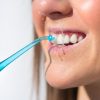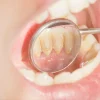Get information about clear aligner treatment with the explanation of specialist dentist Merve Özkan Akagündüz.
Clear Aligner Treatment

Clear Aligners, Doredent İstanbul
In recent years, with the advancement of digital technology, the prevalence of clear aligner treatments, also known as wireless orthodontic treatment, has increased. Traditional or digital measurements taken from the teeth are transferred into a three-dimensional computer environment. Treatment planning is conducted on these digital records to determine the process of how the teeth should move, how long it will take, and how many aligners will be needed.
Treatment planning is shared with the patient and finalized through mutual agreement, after which the production of aligners commences. Using 3D digital printers, the aligners are fabricated and sent to the orthodontist. The process of clear aligner treatment begins with the application of attachments to aid in tooth movement and the delivery of aligners to the patient. Attachments are applied to the outer surface of the teeth using tooth-colored filling material and are removed at the end of treatment.
Clear aligners have become popular, especially among individuals who prioritize aesthetics, as they offer nearly invisible orthodontic treatment. Their flexibility and smoothness provide ease of use and enhance patient comfort. Problems such as wire poking and mouth sores, commonly experienced in traditional treatments, are avoided. Their removability facilitates oral hygiene maintenance, and individuals undergoing clear aligner treatment do not need to change their eating habits. Additionally, the cleaning of aligners is quite simple, requiring only rinsing under running water with liquid soap.
The duration of clear aligner usage varies based on individualized treatment plans, typically ranging from 6 months to 2 years, depending on the severity of the orthodontic problem, the patient’s age, and compliance. It is recommended to wear the aligners for a minimum of 20-22 hours per day, meaning nearly the entire day except for eating and toothbrushing. Each aligner is usually worn for one to two weeks as advised by the orthodontist, followed by the transition to the next aligner. Adherence to the recommended duration of aligner usage is crucial for the success of the treatment.
Clear aligner treatment requires direct patient involvement; therefore, it may not be suitable for individuals lacking discipline and organization. Most cases of mild to moderate dental misalignments can be treated more rapidly with clear aligners compared to traditional methods. For children with skeletal problems in the upper or lower jaw during the developmental stage, different treatment options are usually considered based on the type and severity of the problem, and clear aligners are not recommended.
Individuals interested in clear aligner treatment should first consult an orthodontic specialist to assess treatment suitability. Maximum oral hygiene and completion of all other dental treatments are prerequisites before initiating clear aligner treatment.
Tips for Clear Aligner Treatment:
- Ensure that the aligners are correctly placed by matching the letters and numbers on them with the corresponding jaw.
- When inserting the aligners, start by placing them over the front teeth and apply slight pressure from front to back. Avoid seating the aligners by biting down on them. Once the aligners are in place, confirm their proper seating by biting down on a chewy provided by your orthodontist.
- When removing the aligners, apply force away from the front teeth towards the back teeth. If provided, use the removal tool given by your orthodontist. Avoid using sharp or pointed objects.
- Aligners should be worn for approximately 20-22 hours per day, except during meals and toothbrushing. Failure to comply may lead to treatment-related complications.
- It is advisable not to consume anything other than water while wearing the aligners. Particularly, hot beverages can distort the shape of the aligners and compromise their effectiveness.
- When not in use, aligners should be stored in their case to prevent breakage or loss. Placing them on a tissue on the table increases the risk of disposal. Handle with care.
- If an aligner is lost, the previous aligner can be worn temporarily to prevent reverting to the previous stage of treatment.
- When storing aligners in the case, place them side by side in an overlapping manner, not stacked.
- Brushing the teeth after meals reduces the likelihood of aligners discoloration and odor. If brushing is not possible, at least rinse with water. Aligners can be cleaned under running lukewarm water with liquid soap. They can also be soaked in vinegar or cleaning tablets once or twice a week.
- Although aligners may discolor over time due to usage, this may not pose a significant problem as each aligner is worn for a maximum of 2 weeks. However, reducing cigarette consumption can help prevent teeth from appearing yellowish during this process.
- Even after the completion of the recommended duration of aligner usage, they should be kept in their case. Occasionally, situations may arise where a few aligners need to be revisited.
- In case of attachments becoming loose while wearing clear aligners, inform your orthodontist without delay.
- Engaging in exercises with the chewy provided by your orthodontist during the initial days of wearing new aligners can help facilitate tooth movement.
- It is strongly advised to strictly adhere to your orthodontist’s instructions and to be cautious and diligent throughout your treatment period.
Frequently Asked Questions
Clear aligners affect my speech?
Clear aligners are custom-made using high technology, tailored to fit each individual’s teeth, covering all surfaces visible within the mouth. While there may be differences between companies, generally, the thickness of the aligners ranges from 0.5 mm to 1.5 mm. Their thin structure ensures they don’t create a feeling of heaviness in the mouth. Although they minimally affect the space taken up by the tongue, some slight lisping may be experienced in speech during the first few days. However, this is usually only noticeable to the individual themselves. As the tongue and oral tissues adapt to the aligners over a short period, any lisping sensation diminishes. Clear aligners do not permanently affect speech and do not cause speech impairments.
What is the duration of clear aligner treatment?
Clear aligner treatments, one of the orthodontic treatment methods, have become increasingly popular in recent years. While their popularity stems largely from their aesthetic advantages, they offer a significant advantage by allowing for quicker results, particularly in cases of minor misalignment, compared to traditional braces. The duration of clear aligner treatment varies from person to person, but generally ranges from approximately 6 months to 1.5 years.
How often are clear aligners replaced?
Clear aligner treatments involve the use of a series of trays. Each tray is worn for a period ranging from 1 to 2 weeks. The duration varies depending on the amount of tooth movement planned in the treatment, the patient’s daily wear time for the trays, and the recommendations of the orthodontic specialist.
How is the Cleaning of Clear Aligners Done?
Clear aligners can be cleaned by gently brushing them under lukewarm tap water using a mild liquid soap and a clean toothbrush. For a more effective cleaning, denture cleaning tablets or white vinegar can be used.
Do Clear Aligners Cause Pain?
Regardless of the method used, every orthodontic treatment comes with an adjustment period. This adjustment period is entirely dependent on the individual’s adaptation speed and varies from person to person. While patients may initially be concerned about adaptation when clear aligners are first fitted, significant progress is often made after just a few insertions and removals of the aligners.
The primary objective of clear aligners, like traditional braces, is to move the teeth. Each aligner applies force to the teeth to achieve this movement. This force is most pronounced in the first 2-3 days, during which discomfort may occur. While the discomfort typically does not require the use of painkillers, it can be bothersome to the individual. Over time, the discomfort gradually diminishes until it is no longer noticeable.
Can I Eat with Clear Aligners?
It is ideal not to consume anything other than water while wearing clear aligners. However, if a person has a habit of frequently consuming tea or coffee and removes their aligners for this purpose, they may choose not to remove them depending on the temperature of the beverages. The key here is that the beverages should not be too hot, as clear aligners are thin and delicate and can be affected by heat. A aligner that has lost its function becomes meaningless to use. Additionally, beverages like tea or coffee may cause a slight change in the color of the aligners. Since a change in the color of the aligners can affect the appearance of the teeth, this situation may be discomforting for the patient. However, this issue is temporary because a brand new aligner will eventually be used in the treatment process.
Clear aligners can be affected by chewing forces. Therefore, they must be removed before eating, and after brushing the teeth following a meal, they should be put back on. If food particles are trapped inside the aligners when they are worn over the teeth with food debris adhered to the tooth surface, the food particles will be trapped inside the aligners and can lead to the formation of cavities.
Merve Özkan Akagündüz
I was born in Edirne in 1988. In 2007, I began my master’s degree in Dentistry at Istanbul University (Çapa) Faculty of Dentistry and graduated in 2012.
In 2014, I started my specialization in the Department of Orthodontics at Süleyman Demirel University Faculty of Dentistry. In 2019, I earned the title of Orthodontist and was appointed to Çorlu ADSM, where I worked as an Orthodontic Specialist Dentist from 2019 to 2022.
As of 2024, I have been continuing my practice in my own clinic.








